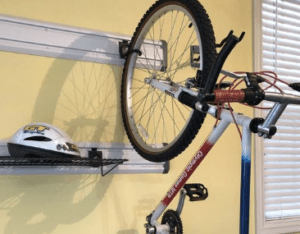Jim is an accomplished triathlete and endurance cyclist, and has raced in more than 35 USAT-certified races. He is also an avid trail runner and endurance gravel bike rider. Jim is a founder of Complete Tri and frequent writer on triathlon and cycling.
Mistakes Cyclists Make When Storing Their Bike for Winter
Cyclists in colder climates often change their cycling patterns as winter sets in. Some move to a smart trainer, others starting going to a gym to cross train or take spin classes. Some might use a Peloton. Others might store their road bike and bring out the fat tire bike.
If you, like us, are in the camp of being not-quite-lucky-enough to cycle outside 12 months a year, there are some things to remember about storing your bike for winter.
Here are the 3 big mistakes we see cyclist make.
Improper Cleaning Before Storage
When it comes to storing a bike for winter, it’s important to clean it thoroughly before putting it away. Improper cleaning can lead to damage and corrosion, making it difficult to get back on the road when spring arrives. Think about the kind of riding you were doing this season, especially in the fall. Whether you were encountering dust, mud, or other debris, that stuff is likely all over your bike’s components.
Ignoring Dirt and Grime
One common mistake cyclists make is ignoring dirt and grime on their bike before storing it. This depends a little on the personality of the cyclist, as some are quite diligent about keeping their bike clean, while others are quite a bit more “relaxed.” Not cleaning your bike can lead to corrosion and damage to the bike’s components, especially if the bike is stored in a damp or humid environment. Obviously, you should take the time to clean your bike thoroughly before putting it away for the winter.
Overlooking Rust
Another mistake I’ve seen cyclists make is overlooking rust forming on their bike. A little rust now turns in to a lot of rust later, and it can cause serious damage to a bike’s components, especially if it’s left untreated for an extended period of time. To prevent rust from forming, cyclists should check their bike for any signs of rust before storing it for the winter. If rust is found, any rust should be removed from the bike and treated before putting the bike away. To be extra sure, give the bike a quick lube before stowing it for the winter.
The goal is to store a perfectly clean and pristine bike.
Ignoring Known Mechanical Issues
I promise that you have a better idea of what needs fixing on your bike now than you will when you pull it out again in March. Don’t store a bike that immediately needs to be fixed next spring! Be sure to address mechanical issues before putting it away. Ignoring mechanical issues can lead to bigger problems down the line and potentially cost more money to fix. Plus, there is a real good chance that, over winter, you will forget all about the mechanical problems, and will have to refresh your memory (the hard way) on what needs to be fixed.
Plus, bringing a bike in to a bike shop now is probably less-expensive and definitely much faster than it will be in spring. Or, if you are proficient as a bike mechanic, you can do the work in your home bike workshop.

Not Addressing Maintenance Issues
Different from major repairs, regular maintenance is crucial for keeping a bike in good condition. Neglecting maintenance issues can result in a bike that is not safe to ride. Before storing a bike for winter, it’s important to address any maintenance issues, such as:
- Lubricating the bike chain
- Checking and adjusting brakes
- Checking and adjusting gears
- Ensuring cables and bearings are in good working order
Inappropriate Storage Methods
Cyclists often make the mistake of storing their bikes in ways that can damage them during the winter months. Here are some inappropriate storage methods to avoid:

Hanging Bikes Incorrectly
Hanging bikes by their wheels is a common storage method, but it can cause damage if done incorrectly. Hanging a bike by the front wheel puts too much stress on the rim and can cause it to warp over time. Hanging a bike by the rear wheel can cause damage to the derailleur or cassette if not done well. The best way to store a bike is by using a vertical bike rack that supports the frame.
If you need to hang a bike by the wheels, be sure the hanging hooks are coated with rubber or a soft material and have plenty of surface area to spread the weight of the bike around. Also, it might go without saying, but be sure that the hooks are mounted securely and into hard, deep wood.

Wedging the Bike Between Other Objects
Storing a bike by leaning it against a wall or wedging it between other objects can cause damage to the frame, especially if the bike falls over. The pressure from the weight of the bike can cause dents or scratches on the frame, which can weaken it over time. It is best to store bikes in a designated area where they won’t be knocked over.
It doesn’t take much weight, over the course of a couple months, to bend a spoke or wear-off your handlebar tape.
Too Much Humidity
Storing a bike in a damp or humid environment can cause rust to form on the frame, chain, and other metal components. This can create rust, and rust is always bad. If you happen to store your bike in a place that gets humid – or lots of condensation – consider having a dehumidifier in the room.
Pay special attention to where and how your bike is stored if you live in a salty, humid environment like the coastal areas of Florida. Although in that climate, you might not need to store your bike very often!







